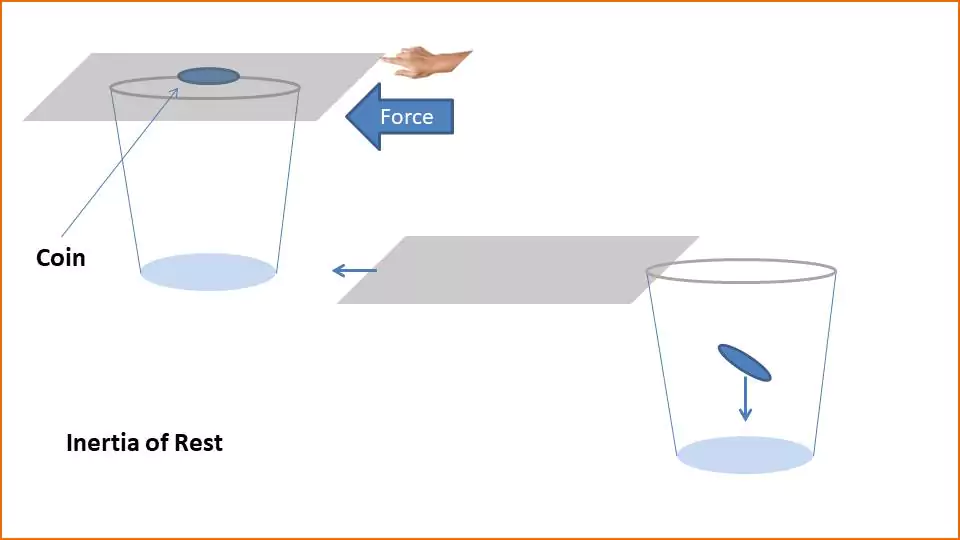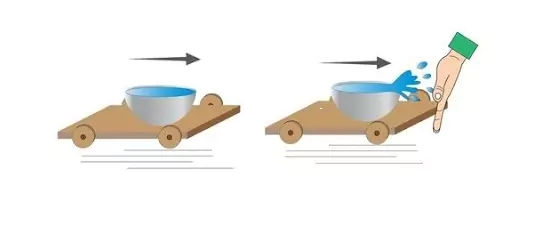In 1687, Sir Isaac Newton published three laws of motion in his famous book ‘Principia’. These laws are called Newton’s laws of motion. These three laws of motion are the foundation of classical mechanics. As a result, dynamics is established on a solid scientific basis. These laws tell us when an object starts moving, or when its speed accelerates or slows down.
An object at rest remains at rest or an object in motion continues to move in a straight line at constant velocity unless acted upon by an external force.
Discussion of the First Law
From the first law, we have learned that to understand whether a force is acting on an object, we need to see whether the velocity of the object is changing. If the velocity of the object does not change or the object is at rest, we need to understand that no external force is acting on the object. Now, what kind of force is being referred to as ‘external force’?
The forces acting on an object can be of two types:
- internal force and
- external force.
Internal force: When a force is applied to an object, if the force is a part of that body, then the applied force cannot change the velocity. That force that only tries to change the velocity (but actually can not change the velocity) is called an internal force.
External force: When a force is applied to an object if the force is applied to the object by a separate or external body, then the applied force changes the velocity of the object or tries to change the velocity. That force is called an external force.
Suppose, you sit on a rickshaw and push the rickshaw, it turns out that the rickshaw does not move. Again, you get down from the rickshaw and push the rickshaw, it turns out that the rickshaw does move. Then, see, you apply force to the rickshaw twice, but the surprising thing is that in the first case, the rickshaw does not move and in the second case, it moves.
The force that you apply to the rickshaw while sitting on the rickshaw is an internal force. This force cannot change the velocity of the object. It only tries to change the velocity. In this case, the person applying the force and the object are the same entity.
Again, the force that you apply to the rickshaw after getting down from the rickshaw is an external force. This force changes the velocity of the object (or tries to change the velocity). In this case, the person applying the force and the object are different entities.
From Newton’s first law of motion, it is understood that it is not possible to change the stable or dynamic state of an object by internal force or external balanced force. It is possible only by external unbalanced force. That is, this external unbalanced force is responsible for the change in speed. And when the speed changes, acceleration is produced.
Again, the tendency of an object to maintain a stable or dynamic state is called inertia. Then it is understood that it is not possible to change the inertia of an object without external unbalanced force.
Info: First Law of Newton explains why motion or rest is maintained in the absence of an external force.
Concept of force from Newton’s first law of motion:
The definition of force obtained from Newton’s first law of motion is qualitative. Unless an external unbalanced force is applied to an object, the velocity of the object does not change. That is, the velocity of the object remains unchanged whether the velocity of the object is zero (or a stationary object) or a certain value (with constant velocity).
Therefore, the things that are known from Newton’s first law of motion are-
- the law of inertia of the object
- the physical definition of force
- the change in the velocity of the object is possible only by an external unbalanced force, not by an internal force.
- a clear statement of the similarity between the stationary and the moving with constant velocity of an object.
Info: Newton’s First Law introduces the concept of force and inertia.
Concept of Inertia of Rest and Inertia of Motion
Take a glass, a postcard and a coin. Place the postcard on the glass and the coin on top of it. Now tap one end of the postcard hard. You will see that the postcard slides out and the coin falls into the glass.

Fill a bowl with water to the brim on top of a toy car. Place the car on the floor. Now push the car forward a little. Tell your friend to stop the car by putting his hand in front of it. As soon as your friend puts his hand in front of it to stop the car, you will see that the water in the bowl moves forward a little and falls ahead.

These two facts show that an object, whether stationary or moving, wants to remain in that state and resists any attempt to change that state. This property of an object is called inertia.
Info: Inertia is the natural tendency of an object to resist changes in its state of motion or rest.
We have learned in the seventh grade that there are two types of inertia – [1] inertia of rest and [II] inertia of motion
The tendency of a stationary object to always remain stationary is called inertia of rest or static inertia.
On the other hand, the tendency of a moving object to always move in a straight line with constant momentum is called inertia of motion or kinetic inertia.
Example of inertia
[i] Some passengers are standing inside a bus. Now when the bus suddenly starts moving, it is seen that the passengers lean backwards. This is because when the car was stationary, the passengers were also stationary. But when the car suddenly starts moving, the lower part of the passengers moves because they are adjacent to the car, but the upper part still wants to remain stationary due to the inertia of rest. So the passengers lean backwards.
[ii] If you take a bucket filled to the brim with water and suddenly push the bucket, some of the water moves backward. This is because when a sudden force is applied to the bucket in the forward direction, the bucket moves forward. But the water in the bucket still wants to remain stationary due to static gravity, so it moves backward.
[iii] While dusting a blanket, the blanket is hung from a support and hit with a stick. It is seen that dust is falling from the blanket. This is because the blanket is suddenly moved towards the applied force due to the strong hit. But the dust loosely attached to it still remains stationary due to static gravity. As a result, the dust separates from the blanket and falls.
Example of inertia
[i] When a moving passenger car suddenly stops, the passengers in the car lean forward or fall over. This is because when the car was moving, the passengers were also moving. But when the car suddenly stopped by applying the brakes, the lower parts of the passengers remained stationary because they were adjacent to the car. But the upper parts moved forward due to inertia, so the passengers leaned forward or fell over.
[ii] Even if an electric fan is switched off, it does not stop immediately, it stops after rotating a few more times due to its inertia of motion.
[iii] In a race, a competitor cannot stop at the finish line, he can stop only after travelling some more distance due to the inertia of motion.
Mathematical Perspective:
Newton’s First Law is a special case of Newton’s Second Law where the net external force Fnet is zero:
Fnet = 0 ⟹ a = 0
a = (v − u)/t = 0
or, v − u = 0
∴ v = u
If the acceleration (a) is zero, the velocity (v) remains constant, and as v=0, the object remains at rest.